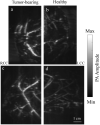Photoacoustic dual-scan mammoscope: results from 38 patients
- PMID: 33996216
- PMCID: PMC8086457
- DOI: 10.1364/BOE.420679
Photoacoustic dual-scan mammoscope: results from 38 patients
Abstract
We have developed a photoacoustics-based imaging system, the dual-scan mammoscope (DSM), that combines optical contrasts with acoustic detection, to obtain the angiographic features in human breast. In this study, we investigated whether the system can differentiate malignant tumor and healthy breast. We have imaged 38 patients with various tumor types and compared results of tumor-bearing breast with healthy breast for each patient. We also compared the photoacoustic and ultrasound imaging results with clinical US. Vascular features in and around the tumor mass were visualized. We found that tumor-bearing breast contained vessels of larger caliber and exhibited stronger variations in the background signals than those in the contralateral healthy breasts. Preliminary data on photoacoustic and ultrasound images also indicate that the technique has potential in differentiating different tumor types. Overall, our results indicate that combining photoacoustic and ultrasound images can improve breast cancer screening.
© 2021 Optical Society of America under the terms of the OSA Open Access Publishing Agreement.
Conflict of interest statement
The authors declare no competing interests. Dr. Jun Xia is the founder of Sonioptix, LLC, which, however, did not support this work.
Figures






References
-
- Nothacker M., Duda V., Hahn M., Warm M., Degenhardt F., Madjar H., Weinbrenner S., Albert U.-S., “Early detection of breast cancer: benefits and risks of supplemental breast ultrasound in asymptomatic women with mammographically dense breast tissue. A systematic review,” BMC Cancer 9(1), 335 (2009).10.1186/1471-2407-9-335 - DOI - PMC - PubMed
Grants and funding
LinkOut - more resources
Full Text Sources
Other Literature Sources
